AVL tree is a self-balancing binary search tree in which each node maintains extra information called a balance factor whose value is either -1, 0 or +1.
AVL tree got its name after its inventor Georgy Adelson-Velsky and Landis.
Balance Factor
Balance factor of a node in an AVL tree is the difference between the height of the left subtree and that of the right subtree of that node.
Balance Factor = (Height of Left Subtree - Height of Right Subtree) or (Height of Right Subtree - Height of Left Subtree)
The self balancing property of an avl tree is maintained by the balance factor. The value of balance factor should always be -1, 0 or +1.
An example of a balanced avl tree is:
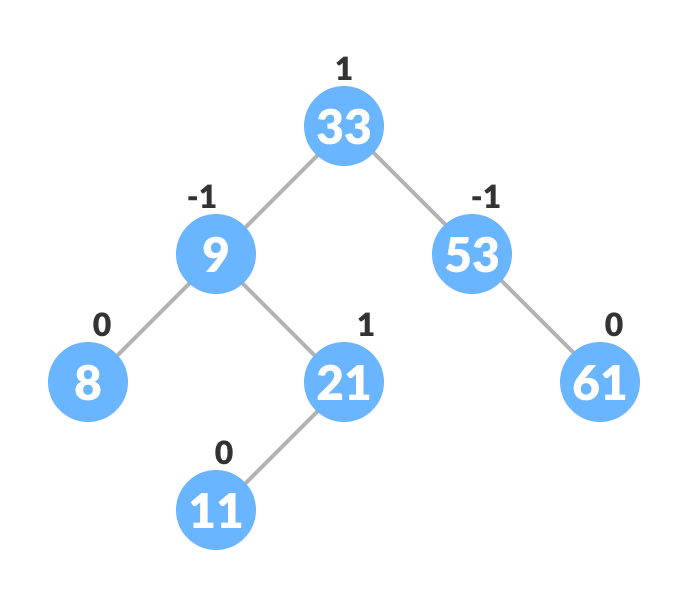
Operations on an AVL tree
Various operations that can be performed on an AVL tree are:
Rotating the subtrees in an AVL Tree
In rotation operation, the positions of the nodes of a subtree are interchanged.
There are two types of rotations:
Left Rotate
In left-rotation, the arrangement of the nodes on the right is transformed into the arrangements on the left node.
Algorithm
- Let the initial tree be:

Left rotate - If y has a left subtree, assign x as the parent of the left subtree of y.
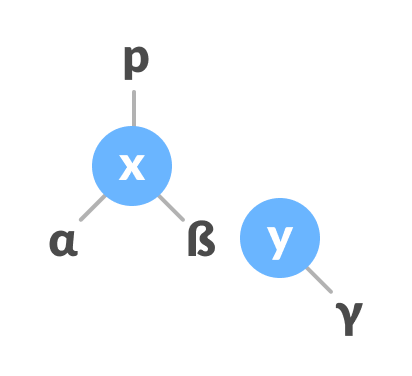
Assign x as the parent of the left subtree of y - If the parent of x is
NULL, make y as the root of the tree. - Else if x is the left child of p, make y as the left child of p.
- Else assign y as the right child of p.
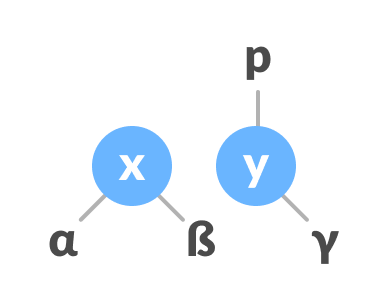
Change the parent of x to that of y - Make y as the parent of x.
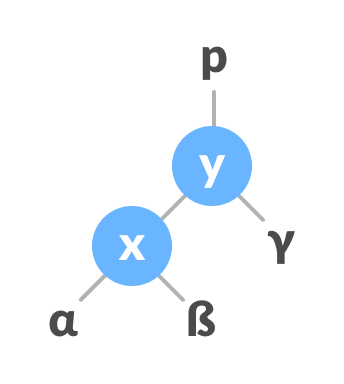
Assign y as the parent of x.
Right Rotate
In left-rotation, the arrangement of the nodes on the left is transformed into the arrangements on the right node.
- Let the initial tree be:
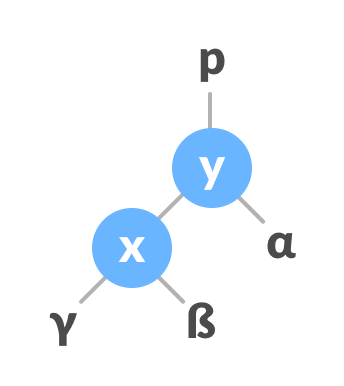
Initial tree - If x has a right subtree, assign y as the parent of the right subtree of x.
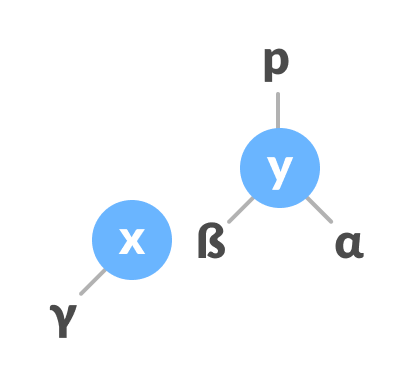
Assign y as the parent of the right subtree of x - If the parent of y is
NULL, make x as the root of the tree. - Else if y is the right child of its parent p, make x as the right child of p.
- Else assign x as the left child of p.
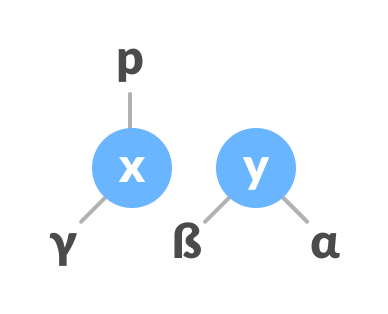
Assign the parent of y as the parent of x. - Make x as the parent of y.
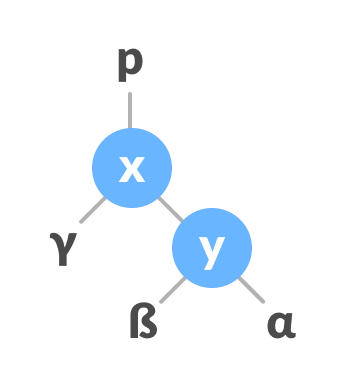
Assign x as the parent of y
Left-Right and Right-Left Rotate
In left-right rotation, the arrangements are first shifted to the left and then to the right.
- Do left rotation on x-y.
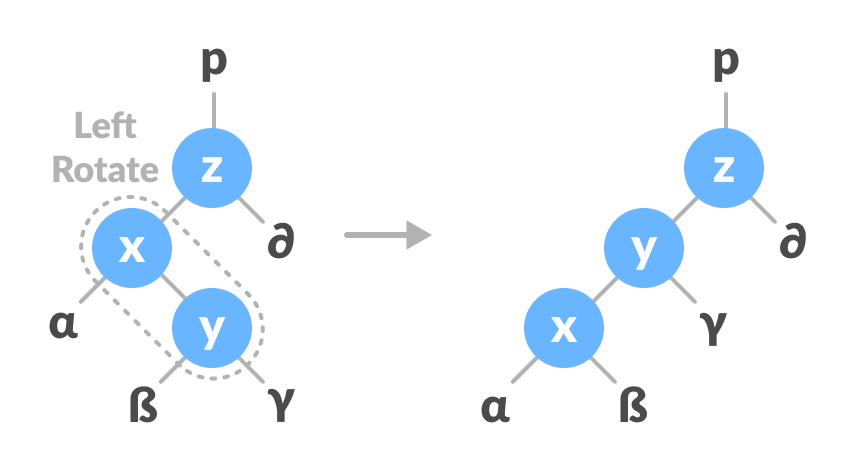
Left rotate x-y - Do right rotation on y-z.
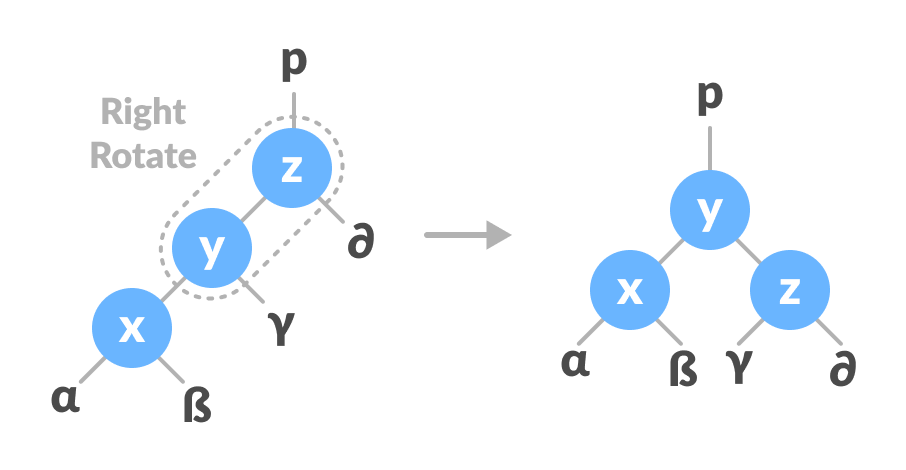
Right rotate z-y
In right-left rotation, the arrangements are first shifted to the right and then to the left.
- Do right rotation on x-y.
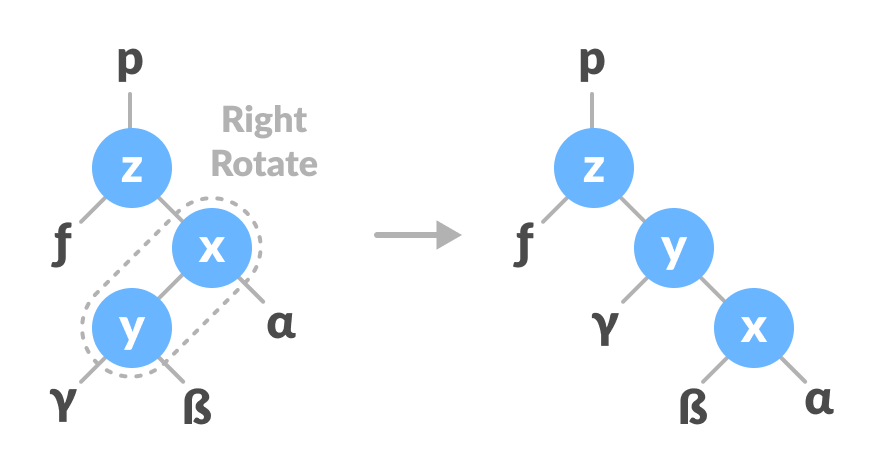
Right rotate x-y - Do left rotation on z-y.
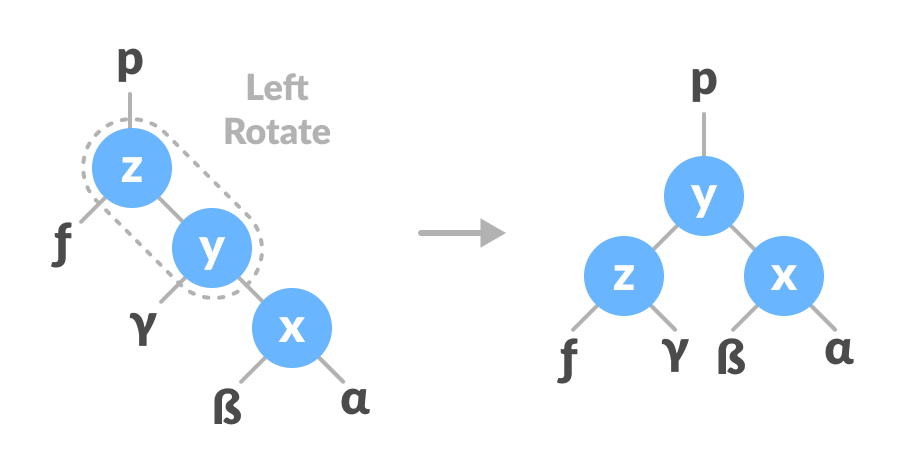
Left rotate z-y
Algorithm to insert a newNode
A newNode is always inserted as a leaf node with balance factor equal to 0.
- Let the initial tree be:
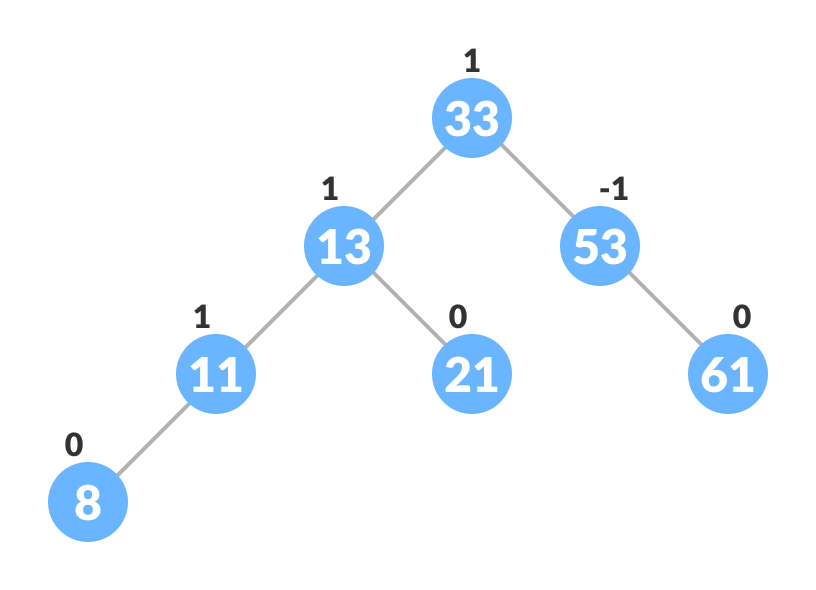
Initial tree for insertion
Let the node to be inserted be:
New node - Go to the appropriate leaf node to insert a newNode using the following recursive steps. Compare newKey with rootKey of the current tree.
- If newKey < rootKey, call insertion algorithm on the left subtree of the current node until the leaf node is reached.
- Else if newKey > rootKey, call insertion algorithm on the right subtree of current node until the leaf node is reached.
- Else, return leafNode.
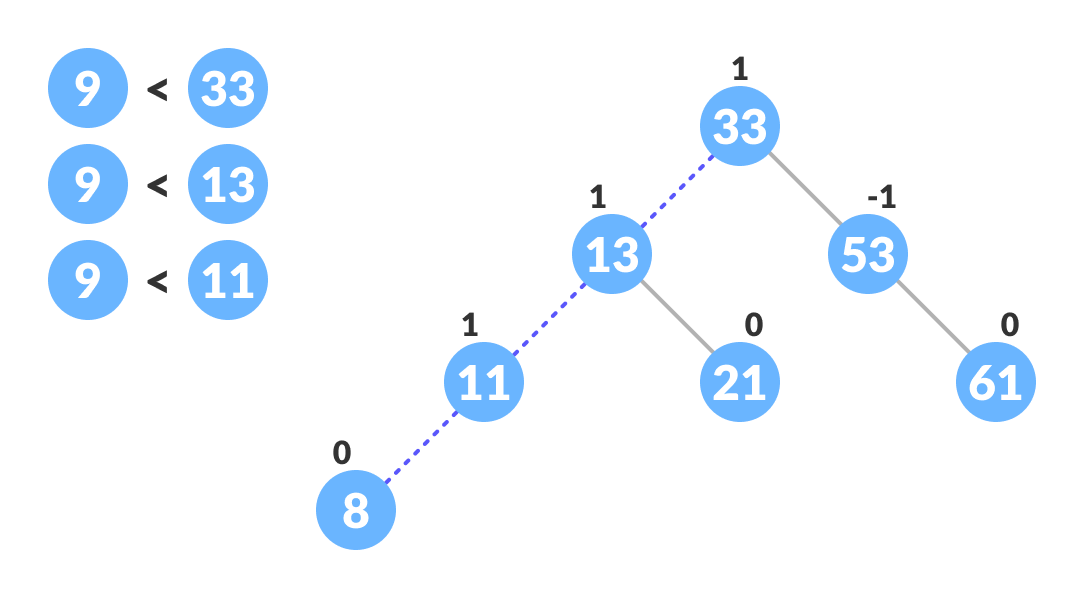
Finding the location to insert newNode
- Compare leafKey obtained from the above steps with newKey:
- If newKey < leafKey, make newNode as the leftChild of leafNode.
- Else, make newNode as rightChild of leafNode.
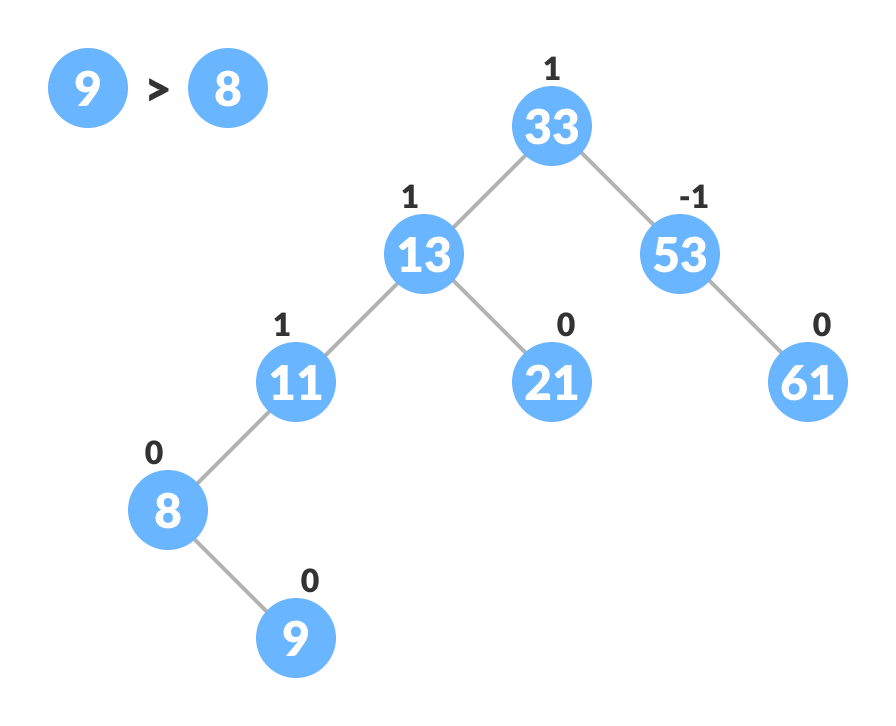
Inserting the new node
- Update balanceFactor of the nodes.
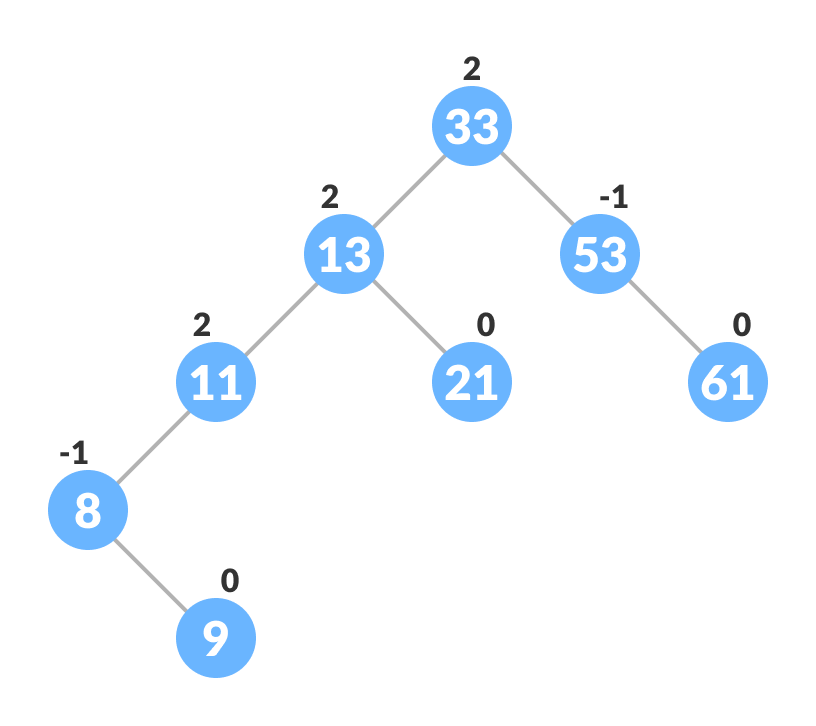
Updating the balance factor after insertion - If the nodes are unbalanced, then rebalance the node.
- If balanceFactor > 1, it means the height of the left subtree is greater than that of the right subtree. So, do a right rotation or left-right rotation
- If newNodeKey < leftChildKey do right rotation.
- Else, do left-right rotation.
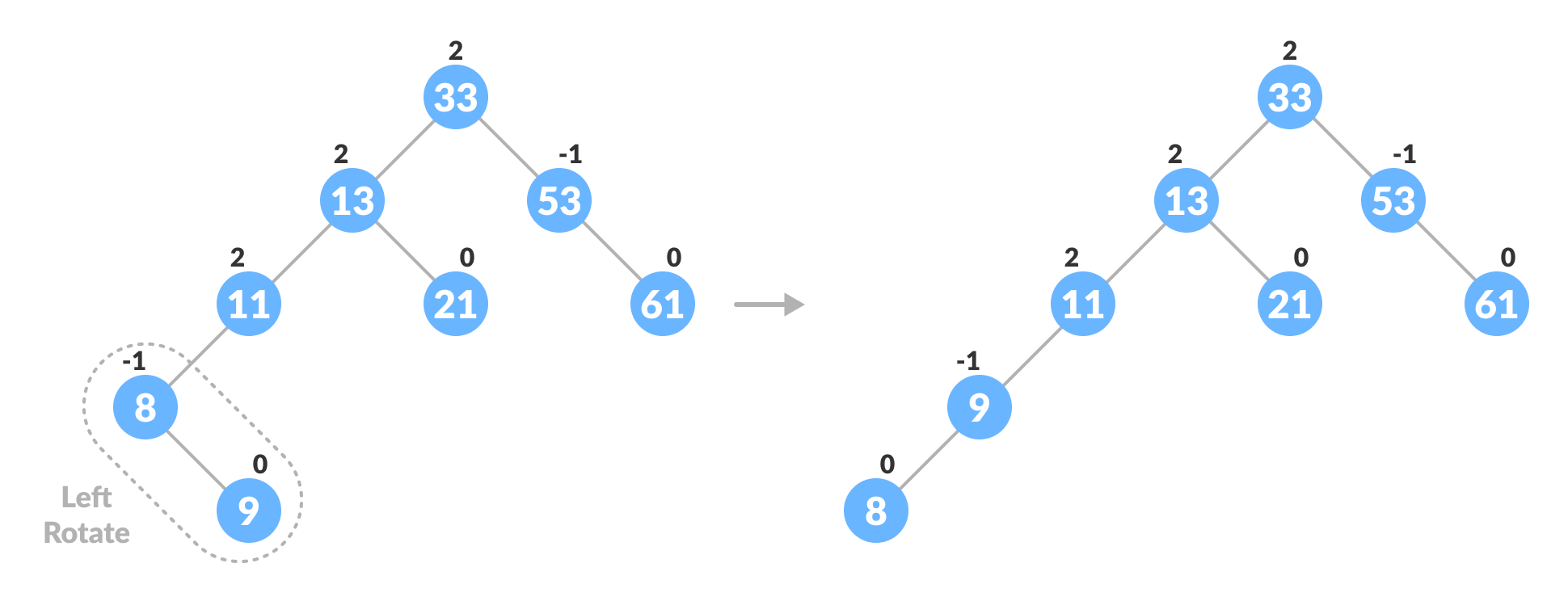
Balancing the tree with rotation 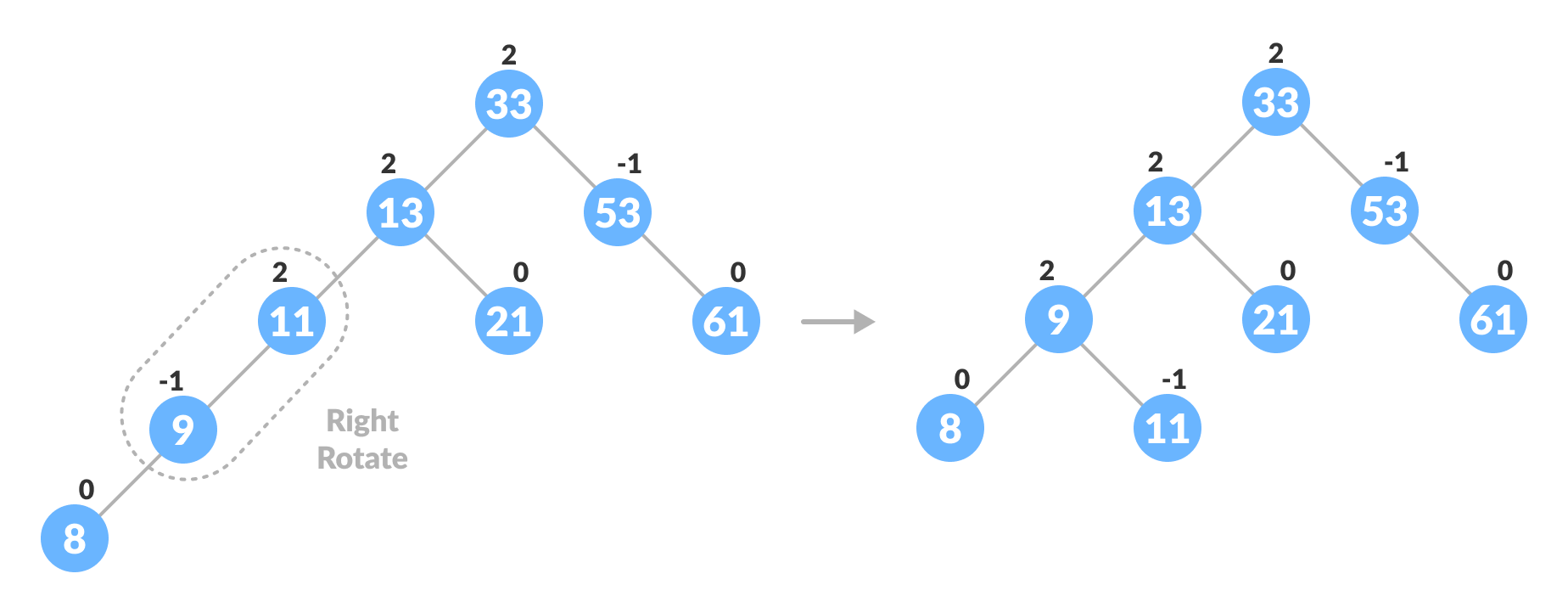
Balancing the tree with rotation
- If balanceFactor < -1, it means the height of the right subtree is greater than that of the left subtree. So, do right rotation or right-left rotation
- If newNodeKey > rightChildKey do left rotation.
- Else, do right-left rotation
- If balanceFactor > 1, it means the height of the left subtree is greater than that of the right subtree. So, do a right rotation or left-right rotation
- The final tree is:
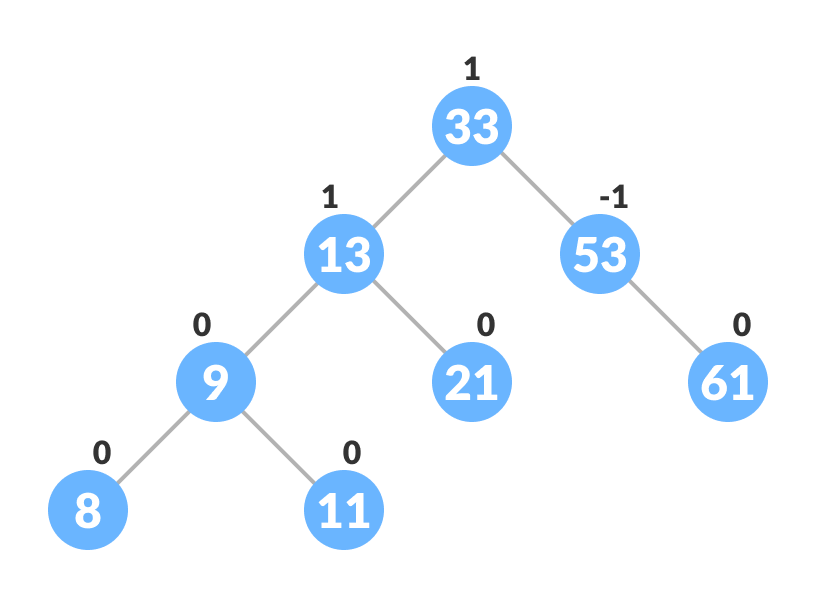
Final balanced tree
Algorithm to Delete a node
A node is always deleted as a leaf node. After deleting a node, the balance factors of the nodes get changed. In order to rebalance the balance factor, suitable rotations are performed.
- Locate nodeToBeDeleted (recursion is used to find nodeToBeDeleted in the code used below).
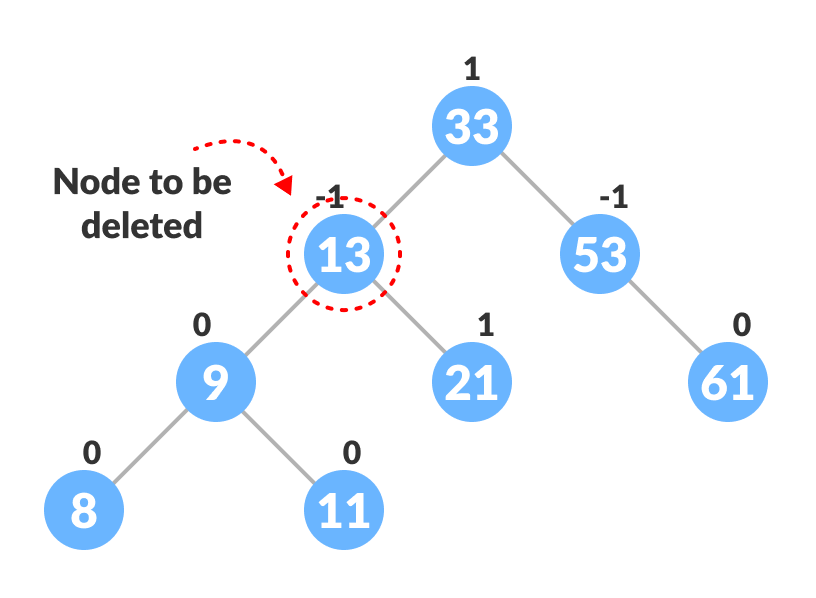
Locating the node to be deleted - There are three cases for deleting a node:
- If nodeToBeDeleted is the leaf node (ie. does not have any child), then remove nodeToBeDeleted.
- If nodeToBeDeleted has one child, then substitute the contents of nodeToBeDeleted with that of the child. Remove the child.
- If nodeToBeDeleted has two children, find the inorder successor w of nodeToBeDeleted (ie. node with a minimum value of key in the right subtree).
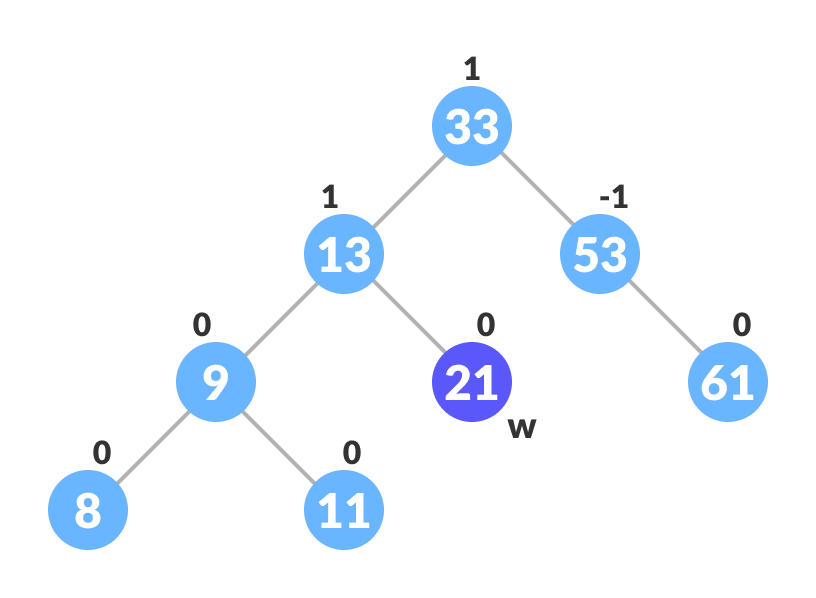
Finding the successor - Substitute the contents of nodeToBeDeleted with that of w.

Substitute the node to be deleted - Remove the leaf node w.
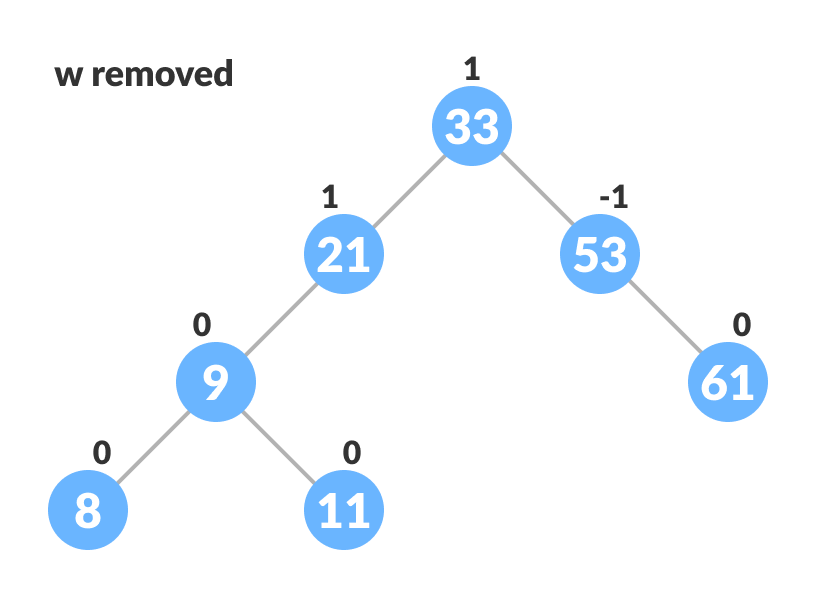
Remove w
- Substitute the contents of nodeToBeDeleted with that of w.
- Update balanceFactor of the nodes.
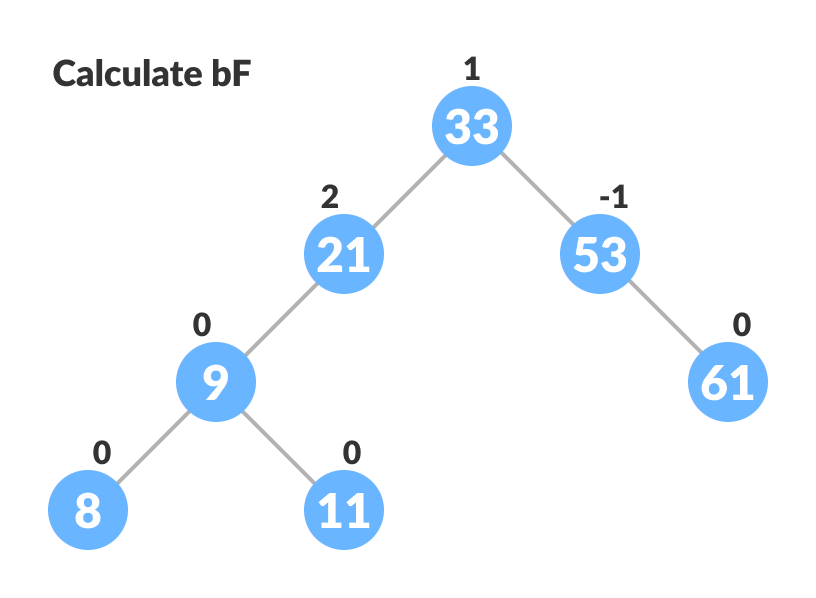
Update bf - Rebalance the tree if the balance factor of any of the nodes is not equal to -1, 0 or 1.
- If balanceFactor of currentNode > 1,
- If balanceFactor of leftChild >= 0, do right rotation.

Right-rotate for balancing the tree - Else do left-right rotation.
- If balanceFactor of leftChild >= 0, do right rotation.
- If balanceFactor of currentNode < -1,
- If balanceFactor of rightChild <= 0, do left rotation.
- Else do right-left rotation.
- If balanceFactor of currentNode > 1,
- The final tree is:

Avl tree final
Python, Java and C/C++ Examples
# AVL tree implementation in Python
import sys
# Create a tree node
class TreeNode(object):
def __init__(self, key):
self.key = key
self.left = None
self.right = None
self.height = 1
class AVLTree(object):
# Function to insert a node
def insert_node(self, root, key):
# Find the correct location and insert the node
if not root:
return TreeNode(key)
elif key < root.key:
root.left = self.insert_node(root.left, key)
else:
root.right = self.insert_node(root.right, key)
root.height = 1 + max(self.getHeight(root.left),
self.getHeight(root.right))
# Update the balance factor and balance the tree
balanceFactor = self.getBalance(root)
if balanceFactor > 1:
if key < root.left.key:
return self.rightRotate(root)
else:
root.left = self.leftRotate(root.left)
return self.rightRotate(root)
if balanceFactor < -1:
if key > root.right.key:
return self.leftRotate(root)
else:
root.right = self.rightRotate(root.right)
return self.leftRotate(root)
return root
# Function to delete a node
def delete_node(self, root, key):
# Find the node to be deleted and remove it
if not root:
return root
elif key < root.key:
root.left = self.delete_node(root.left, key)
elif key > root.key:
root.right = self.delete_node(root.right, key)
else:
if root.left is None:
temp = root.right
root = None
return temp
elif root.right is None:
temp = root.left
root = None
return temp
temp = self.getMinValueNode(root.right)
root.key = temp.key
root.right = self.delete_node(root.right,
temp.key)
if root is None:
return root
# Update the balance factor of nodes
root.height = 1 + max(self.getHeight(root.left),
self.getHeight(root.right))
balanceFactor = self.getBalance(root)
# Balance the tree
if balanceFactor > 1:
if self.getBalance(root.left) >= 0:
return self.rightRotate(root)
else:
root.left = self.leftRotate(root.left)
return self.rightRotate(root)
if balanceFactor < -1:
if self.getBalance(root.right) <= 0:
return self.leftRotate(root)
else:
root.right = self.rightRotate(root.right)
return self.leftRotate(root)
return root
# Function to perform left rotation
def leftRotate(self, z):
y = z.right
T2 = y.left
y.left = z
z.right = T2
z.height = 1 + max(self.getHeight(z.left),
self.getHeight(z.right))
y.height = 1 + max(self.getHeight(y.left),
self.getHeight(y.right))
return y
# Function to perform right rotation
def rightRotate(self, z):
y = z.left
T3 = y.right
y.right = z
z.left = T3
z.height = 1 + max(self.getHeight(z.left),
self.getHeight(z.right))
y.height = 1 + max(self.getHeight(y.left),
self.getHeight(y.right))
return y
# Get the height of the node
def getHeight(self, root):
if not root:
return 0
return root.height
# Get balance factore of the node
def getBalance(self, root):
if not root:
return 0
return self.getHeight(root.left) - self.getHeight(root.right)
def getMinValueNode(self, root):
if root is None or root.left is None:
return root
return self.getMinValueNode(root.left)
def preOrder(self, root):
if not root:
return
print("{0} ".format(root.key), end="")
self.preOrder(root.left)
self.preOrder(root.right)
# Print the tree
def printHelper(self, currPtr, indent, last):
if currPtr != None:
sys.stdout.write(indent)
if last:
sys.stdout.write("R----")
indent += " "
else:
sys.stdout.write("L----")
indent += "| "
print(currPtr.key)
self.printHelper(currPtr.left, indent, False)
self.printHelper(currPtr.right, indent, True)
myTree = AVLTree()
root = None
nums = [33, 13, 52, 9, 21, 61, 8, 11]
for num in nums:
root = myTree.insert_node(root, num)
myTree.printHelper(root, "", True)
key = 13
root = myTree.delete_node(root, key)
print("After Deletion: ")
myTree.printHelper(root, "", True)// AVL tree implementation in Java
// Create node
class Node {
int item, height;
Node left, right;
Node(int d) {
item = d;
height = 1;
}
}
// Tree class
class AVLTree {
Node root;
int height(Node N) {
if (N == null)
return 0;
return N.height;
}
int max(int a, int b) {
return (a > b) ? a : b;
}
Node rightRotate(Node y) {
Node x = y.left;
Node T2 = x.right;
x.right = y;
y.left = T2;
y.height = max(height(y.left), height(y.right)) + 1;
x.height = max(height(x.left), height(x.right)) + 1;
return x;
}
Node leftRotate(Node x) {
Node y = x.right;
Node T2 = y.left;
y.left = x;
x.right = T2;
x.height = max(height(x.left), height(x.right)) + 1;
y.height = max(height(y.left), height(y.right)) + 1;
return y;
}
// Get balance factor of a node
int getBalanceFactor(Node N) {
if (N == null)
return 0;
return height(N.left) - height(N.right);
}
// Insert a node
Node insertNode(Node node, int item) {
// Find the position and insert the node
if (node == null)
return (new Node(item));
if (item < node.item)
node.left = insertNode(node.left, item);
else if (item > node.item)
node.right = insertNode(node.right, item);
else
return node;
// Update the balance factor of each node
// And, balance the tree
node.height = 1 + max(height(node.left), height(node.right));
int balanceFactor = getBalanceFactor(node);
if (balanceFactor > 1) {
if (item < node.left.item) {
return rightRotate(node);
} else if (item > node.left.item) {
node.left = leftRotate(node.left);
return rightRotate(node);
}
}
if (balanceFactor < -1) {
if (item > node.right.item) {
return leftRotate(node);
} else if (item < node.right.item) {
node.right = rightRotate(node.right);
return leftRotate(node);
}
}
return node;
}
Node nodeWithMimumValue(Node node) {
Node current = node;
while (current.left != null)
current = current.left;
return current;
}
// Delete a node
Node deleteNode(Node root, int item) {
// Find the node to be deleted and remove it
if (root == null)
return root;
if (item < root.item)
root.left = deleteNode(root.left, item);
else if (item > root.item)
root.right = deleteNode(root.right, item);
else {
if ((root.left == null) || (root.right == null)) {
Node temp = null;
if (temp == root.left)
temp = root.right;
else
temp = root.left;
if (temp == null) {
temp = root;
root = null;
} else
root = temp;
} else {
Node temp = nodeWithMimumValue(root.right);
root.item = temp.item;
root.right = deleteNode(root.right, temp.item);
}
}
if (root == null)
return root;
// Update the balance factor of each node and balance the tree
root.height = max(height(root.left), height(root.right)) + 1;
int balanceFactor = getBalanceFactor(root);
if (balanceFactor > 1) {
if (getBalanceFactor(root.left) >= 0) {
return rightRotate(root);
} else {
root.left = leftRotate(root.left);
return rightRotate(root);
}
}
if (balanceFactor < -1) {
if (getBalanceFactor(root.right) <= 0) {
return leftRotate(root);
} else {
root.right = rightRotate(root.right);
return leftRotate(root);
}
}
return root;
}
void preOrder(Node node) {
if (node != null) {
System.out.print(node.item + " ");
preOrder(node.left);
preOrder(node.right);
}
}
// Print the tree
private void printTree(Node currPtr, String indent, boolean last) {
if (currPtr != null) {
System.out.print(indent);
if (last) {
System.out.print("R----");
indent += " ";
} else {
System.out.print("L----");
indent += "| ";
}
System.out.println(currPtr.item);
printTree(currPtr.left, indent, false);
printTree(currPtr.right, indent, true);
}
}
// Driver code
public static void main(String[] args) {
AVLTree tree = new AVLTree();
tree.root = tree.insertNode(tree.root, 33);
tree.root = tree.insertNode(tree.root, 13);
tree.root = tree.insertNode(tree.root, 53);
tree.root = tree.insertNode(tree.root, 9);
tree.root = tree.insertNode(tree.root, 21);
tree.root = tree.insertNode(tree.root, 61);
tree.root = tree.insertNode(tree.root, 8);
tree.root = tree.insertNode(tree.root, 11);
tree.printTree(tree.root, "", true);
tree.root = tree.deleteNode(tree.root, 13);
System.out.println("After Deletion: ");
tree.printTree(tree.root, "", true);
}
}// AVL tree implementation in C
#include <stdio.h>
#include <stdlib.h>
// Create Node
struct Node {
int key;
struct Node *left;
struct Node *right;
int height;
};
int max(int a, int b);
// Calculate height
int height(struct Node *N) {
if (N == NULL)
return 0;
return N->height;
}
int max(int a, int b) {
return (a > b) ? a : b;
}
// Create a node
struct Node *newNode(int key) {
struct Node *node = (struct Node *)
malloc(sizeof(struct Node));
node->key = key;
node->left = NULL;
node->right = NULL;
node->height = 1;
return (node);
}
// Right rotate
struct Node *rightRotate(struct Node *y) {
struct Node *x = y->left;
struct Node *T2 = x->right;
x->right = y;
y->left = T2;
y->height = max(height(y->left), height(y->right)) + 1;
x->height = max(height(x->left), height(x->right)) + 1;
return x;
}
// Left rotate
struct Node *leftRotate(struct Node *x) {
struct Node *y = x->right;
struct Node *T2 = y->left;
y->left = x;
x->right = T2;
x->height = max(height(x->left), height(x->right)) + 1;
y->height = max(height(y->left), height(y->right)) + 1;
return y;
}
// Get the balance factor
int getBalance(struct Node *N) {
if (N == NULL)
return 0;
return height(N->left) - height(N->right);
}
// Insert node
struct Node *insertNode(struct Node *node, int key) {
// Find the correct position to insertNode the node and insertNode it
if (node == NULL)
return (newNode(key));
if (key < node->key)
node->left = insertNode(node->left, key);
else if (key > node->key)
node->right = insertNode(node->right, key);
else
return node;
// Update the balance factor of each node and
// Balance the tree
node->height = 1 + max(height(node->left),
height(node->right));
int balance = getBalance(node);
if (balance > 1 && key < node->left->key)
return rightRotate(node);
if (balance < -1 && key > node->right->key)
return leftRotate(node);
if (balance > 1 && key > node->left->key) {
node->left = leftRotate(node->left);
return rightRotate(node);
}
if (balance < -1 && key < node->right->key) {
node->right = rightRotate(node->right);
return leftRotate(node);
}
return node;
}
struct Node *minValueNode(struct Node *node) {
struct Node *current = node;
while (current->left != NULL)
current = current->left;
return current;
}
// Delete a nodes
struct Node *deleteNode(struct Node *root, int key) {
// Find the node and delete it
if (root == NULL)
return root;
if (key < root->key)
root->left = deleteNode(root->left, key);
else if (key > root->key)
root->right = deleteNode(root->right, key);
else {
if ((root->left == NULL) || (root->right == NULL)) {
struct Node *temp = root->left ? root->left : root->right;
if (temp == NULL) {
temp = root;
root = NULL;
} else
*root = *temp;
free(temp);
} else {
struct Node *temp = minValueNode(root->right);
root->key = temp->key;
root->right = deleteNode(root->right, temp->key);
}
}
if (root == NULL)
return root;
// Update the balance factor of each node and
// balance the tree
root->height = 1 + max(height(root->left),
height(root->right));
int balance = getBalance(root);
if (balance > 1 && getBalance(root->left) >= 0)
return rightRotate(root);
if (balance > 1 && getBalance(root->left) < 0) {
root->left = leftRotate(root->left);
return rightRotate(root);
}
if (balance < -1 && getBalance(root->right) <= 0)
return leftRotate(root);
if (balance < -1 && getBalance(root->right) > 0) {
root->right = rightRotate(root->right);
return leftRotate(root);
}
return root;
}
// Print the tree
void printPreOrder(struct Node *root) {
if (root != NULL) {
printf("%d ", root->key);
printPreOrder(root->left);
printPreOrder(root->right);
}
}
int main() {
struct Node *root = NULL;
root = insertNode(root, 2);
root = insertNode(root, 1);
root = insertNode(root, 7);
root = insertNode(root, 4);
root = insertNode(root, 5);
root = insertNode(root, 3);
root = insertNode(root, 8);
printPreOrder(root);
root = deleteNode(root, 3);
printf("\nAfter deletion: ");
printPreOrder(root);
return 0;
}// AVL tree implementation in C++
#include <iostream>
using namespace std;
class Node {
public:
int key;
Node *left;
Node *right;
int height;
};
int max(int a, int b);
// Calculate height
int height(Node *N) {
if (N == NULL)
return 0;
return N->height;
}
int max(int a, int b) {
return (a > b) ? a : b;
}
// New node creation
Node *newNode(int key) {
Node *node = new Node();
node->key = key;
node->left = NULL;
node->right = NULL;
node->height = 1;
return (node);
}
// Rotate right
Node *rightRotate(Node *y) {
Node *x = y->left;
Node *T2 = x->right;
x->right = y;
y->left = T2;
y->height = max(height(y->left),
height(y->right)) +
1;
x->height = max(height(x->left),
height(x->right)) +
1;
return x;
}
// Rotate left
Node *leftRotate(Node *x) {
Node *y = x->right;
Node *T2 = y->left;
y->left = x;
x->right = T2;
x->height = max(height(x->left),
height(x->right)) +
1;
y->height = max(height(y->left),
height(y->right)) +
1;
return y;
}
// Get the balance factor of each node
int getBalanceFactor(Node *N) {
if (N == NULL)
return 0;
return height(N->left) -
height(N->right);
}
// Insert a node
Node *insertNode(Node *node, int key) {
// Find the correct postion and insert the node
if (node == NULL)
return (newNode(key));
if (key < node->key)
node->left = insertNode(node->left, key);
else if (key > node->key)
node->right = insertNode(node->right, key);
else
return node;
// Update the balance factor of each node and
// balance the tree
node->height = 1 + max(height(node->left),
height(node->right));
int balanceFactor = getBalanceFactor(node);
if (balanceFactor > 1) {
if (key < node->left->key) {
return rightRotate(node);
} else if (key > node->left->key) {
node->left = leftRotate(node->left);
return rightRotate(node);
}
}
if (balanceFactor < -1) {
if (key > node->right->key) {
return leftRotate(node);
} else if (key < node->right->key) {
node->right = rightRotate(node->right);
return leftRotate(node);
}
}
return node;
}
// Node with minimum value
Node *nodeWithMimumValue(Node *node) {
Node *current = node;
while (current->left != NULL)
current = current->left;
return current;
}
// Delete a node
Node *deleteNode(Node *root, int key) {
// Find the node and delete it
if (root == NULL)
return root;
if (key < root->key)
root->left = deleteNode(root->left, key);
else if (key > root->key)
root->right = deleteNode(root->right, key);
else {
if ((root->left == NULL) ||
(root->right == NULL)) {
Node *temp = root->left ? root->left : root->right;
if (temp == NULL) {
temp = root;
root = NULL;
} else
*root = *temp;
free(temp);
} else {
Node *temp = nodeWithMimumValue(root->right);
root->key = temp->key;
root->right = deleteNode(root->right,
temp->key);
}
}
if (root == NULL)
return root;
// Update the balance factor of each node and
// balance the tree
root->height = 1 + max(height(root->left),
height(root->right));
int balanceFactor = getBalanceFactor(root);
if (balanceFactor > 1) {
if (getBalanceFactor(root->left) >= 0) {
return rightRotate(root);
} else {
root->left = leftRotate(root->left);
return rightRotate(root);
}
}
if (balanceFactor < -1) {
if (getBalanceFactor(root->right) <= 0) {
return leftRotate(root);
} else {
root->right = rightRotate(root->right);
return leftRotate(root);
}
}
return root;
}
// Print the tree
void printTree(Node *root, string indent, bool last) {
if (root != nullptr) {
cout << indent;
if (last) {
cout << "R----";
indent += " ";
} else {
cout << "L----";
indent += "| ";
}
cout << root->key << endl;
printTree(root->left, indent, false);
printTree(root->right, indent, true);
}
}
int main() {
Node *root = NULL;
root = insertNode(root, 33);
root = insertNode(root, 13);
root = insertNode(root, 53);
root = insertNode(root, 9);
root = insertNode(root, 21);
root = insertNode(root, 61);
root = insertNode(root, 8);
root = insertNode(root, 11);
printTree(root, "", true);
root = deleteNode(root, 13);
cout << "After deleting " << endl;
printTree(root, "", true);
}Complexities of Different Operations on an AVL Tree
| Insertion | Deletion | Search |
| O(log n) | O(log n) | O(log n) |
AVL Tree Applications
- For indexing large records in databases
- For searching in large databases

